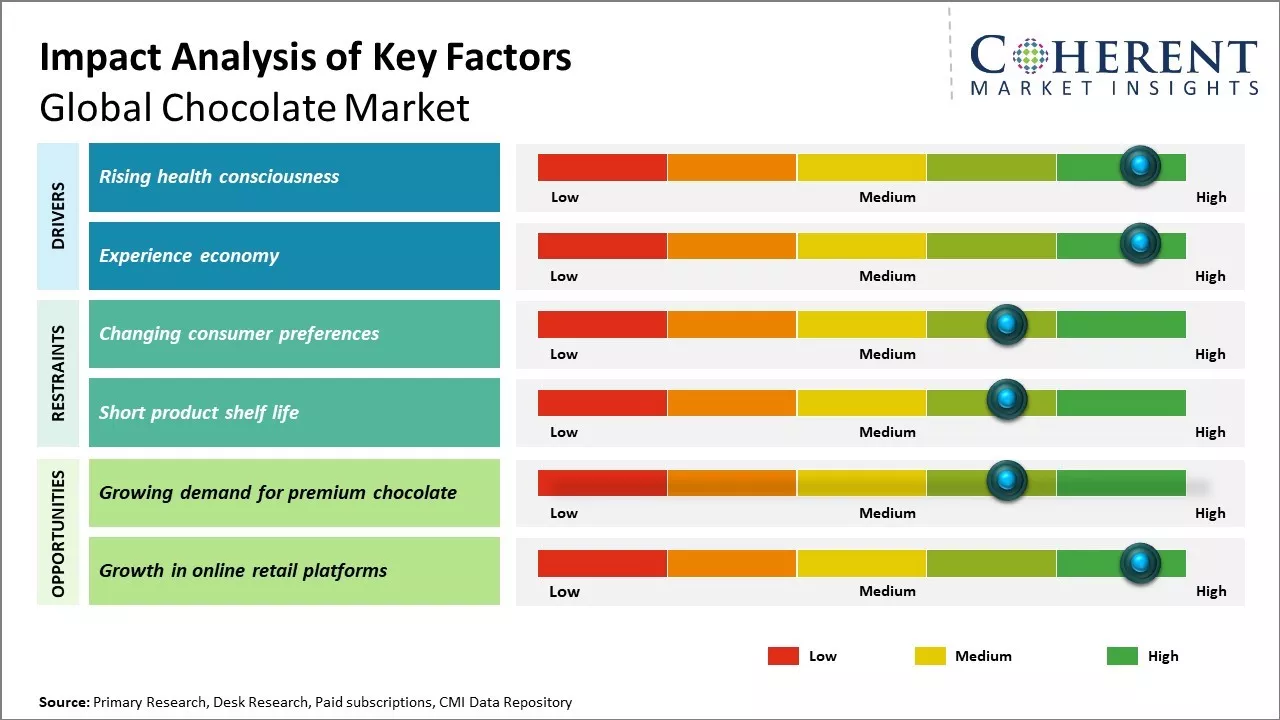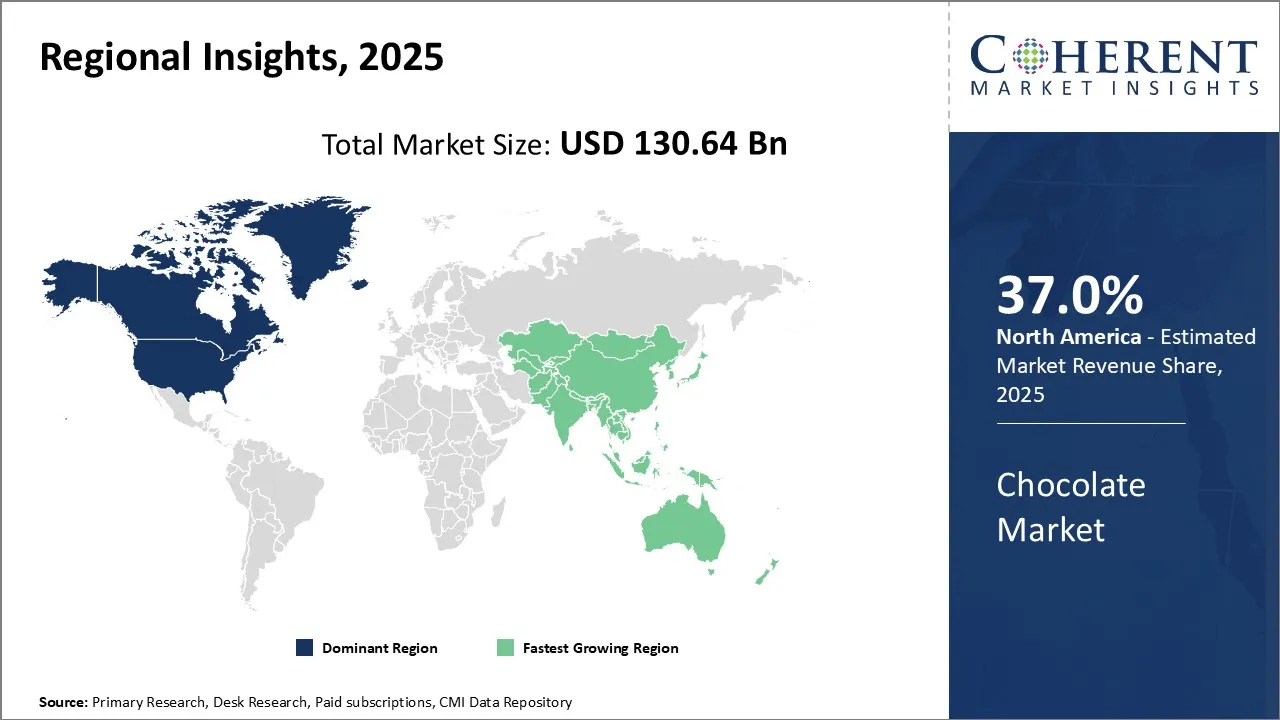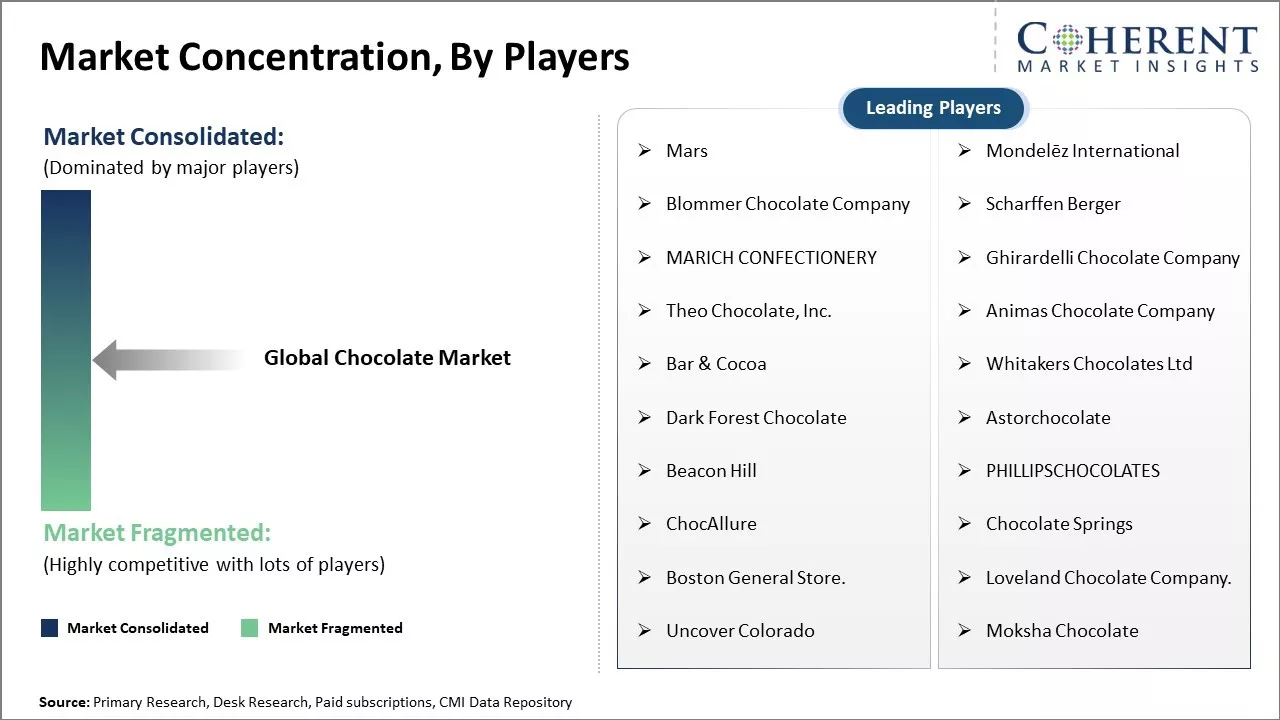The chocolate market is estimated to be valued at USD 130.64 Bn in 2025 and is expected to reach USD 180.29 Bn by 2032, exhibiting a compound annual growth rate (CAGR) of 4.7% from 2025 to 2032.

To learn more about this report, Download Free Sample
The rising demand for premium chocolates among consumers is driving the market growth. Premium chocolate products made from high-quality ingredients are gaining popularity worldwide. Moreover, the launch of new flavors and innovative packaging solutions by leading manufacturers is expanding the consumer base. Increased health awareness has also boosted the demand for dark chocolates that offer various health benefits. However, volatility in cocoa bean prices remains a key challenge. But the growing adoption of sustainable cocoa sourcing practices by major players is expected to ensure long term price stability. Overall, the increased consumption of chocolates as a gifting item or self-indulgence product will continue supporting the market growth over the forecast period.
|
Current Event |
Description and its Impact |
|
West African Cocoa Production Crisis and Climate-Driven Supply Disruptions |
|
|
EU Deforestation Regulation (EUDR) Implementation and Sustainability Compliance |
|
Uncover macros and micros vetted on 75+ parameters: Get instant access to report
Within the product type segment, milk chocolate is expected to claim 50.2% share of the market in 2025, due to its broad consumer appeal, creamy texture, and sweet flavor that resonates across age groups. It’s more affordable than premium varieties, making it accessible for everyday indulgence. Its versatility in formats including, bars, truffles, and coated snacks, keeps it relevant across occasions. Strong visibility in supermarkets and convenience stores boosts impulse purchases, while emotional ties to comfort and gifting traditions enhance seasonal demand. Aggressive marketing by top brands and its presence in both mass and premium segments further solidify its dominance, making milk chocolate the most demanded product type globally in 2025.
For instance, in September 2025, Cadbury Dairy Milk introduced Milkinis, a new crème-filled chocolate bar, to the Indian market. Designed to offer a smooth and indulgent experience, Milkinis combines rich milk chocolate with a creamy center. The launch aims to expand Cadbury’s product portfolio and cater to evolving consumer preferences for novel and indulgent treats.
Within the distribution channel segment, supermarkets/hypermarkets segment is expected to claim 39.3% share of the market in 2025 due to their convenience, variety, and strategic retail presence. These stores offer a wide range of chocolate products, from budget to premium, catering to diverse consumer preferences. Their large shelf space allows for attractive displays and seasonal promotions, boosting impulse purchases. Consumers prefer these outlets for bulk buying and easy access during regular grocery trips. Additionally, supermarkets often run discounts and bundle offers, making them ideal for price-sensitive shoppers. Their high foot traffic and established brand partnerships make them key launchpads for new products, reinforcing their role as the leading distribution channel.
For instance, in July 2025, Cadbury Bournville launched new chocolate bars and introduced a bold packaging redesign to refresh its brand identity. The update aims to attract modern consumers while celebrating Bournville’s rich heritage. With innovative flavors and eye-catching visuals, the brand seeks to strengthen its premium positioning in the competitive chocolate market share.

To learn more about this report, Download Free Sample
The North America region has emerged as the dominant market for chocolate over the past decade. The region is expected to hold 37.0% of the market share in 2025. With the U.S. as the single largest consumer market globally, chocolate manufacturers have established strong production and distribution presence in the region. Some of the key factors contributing to North America's prominence include the widespread popularity of chocolate confectionery products among consumers across demographics and a well-developed retail landscape catering to both impulse as well as planned chocolate purchases. Additionally, the regional market is characterized by aggressive marketing strategies launched by major brands to promote new product innovations as well as line extensions.
For instance, in September 2025, Ferrero North America unveiled a white chocolate version of its classic Crunch bar, just in time for Halloween. This fan-favorite twist combines creamy white chocolate with crispy rice, offering a festive treat for seasonal celebrations. The limited-edition release aims to delight consumers seeking new flavors during the holiday
The Asia Pacific market, shows promising signs of becoming the fastest growing regional market for chocolate in the coming years. Factors such as rapid economic development, growing spending power of middle-income groups, and evolving dietary preferences of young, urban populations are driving significant interest in chocolate and Western snacks. Additionally, Southeast Asian countries like Indonesia, Thailand, and Vietnam present relatively untapped opportunities for international chocolate brands given currently low per capita consumption compared to more mature markets. Local manufacturers are also enhancing their capabilities to cater to the burgeoning domestic demand.
For instance, in January 2025, Muji introduced three new lime-fermented chocolate products crafted from Indonesian cacao. This innovative launch highlights Muji’s commitment to unique flavor profiles and sustainable sourcing. The products aim to offer a refined taste experience while promoting Indonesian cacao, appealing to health-conscious and adventurous chocolate lovers across Asia.
In 2025, the U.S. chocolate market sees strong demand driven by premiumization, health-conscious choices, and seasonal gifting. Consumers favor artisanal, low-sugar, and ethically sourced chocolates, while innovation in flavors and formats boosts appeal. Wide retail access and e-commerce growth further support rising consumption, making the U.S. a dominant force in global chocolate market share.
For instance, in October 2025, A.J. Chocolate House opened its second U.S. location in Houston, Texas, marking a significant step in its expansion strategy. Known for its handcrafted Belgian chocolates and luxurious offerings, the brand aims to bring premium chocolate experiences to more American consumers, reinforcing its presence in the growing artisanal chocolate market.
China’s chocolate market is growing due to rising disposable incomes, urbanization, and evolving consumer tastes. Demand is driven by premiumization, health-conscious choices, and gifting culture. Younger consumers favor artisanal and imported chocolates, while e-commerce and retail expansion boost accessibility. Strategic partnerships and local flavor innovations also contribute to increased chocolate market share in China.
For instance, in October 2024, Ferrero launched a full range of products under its Nutella brand in China, including spreads, biscuits, and B-ready bars. This strategic expansion aims to tap into China’s growing demand for premium chocolate and hazelnut products. The move strengthens Ferrero’s presence in the region and caters to evolving consumer tastes.
| Report Coverage | Details | ||
|---|---|---|---|
| Base Year: | 2024 | Market Size in 2025: | USD 130.64 Bn |
| Historical Data for: | 2020 To 2024 | Forecast Period: | 2025 To 2032 |
| Forecast Period 2025 to 2032 CAGR: | 4.7% | 2032 Value Projection: | USD 180.29 Bn |
| Geographies covered: |
|
||
| Segments covered: |
|
||
| Companies covered: |
Mars, Mondelēz International, Blommer Chocolate Company, Scharffen Berger, MARICH CONFECTIONERY, Ghirardelli Chocolate Company, Theo Chocolate, Inc., Animas Chocolate Company, Bar & Cocoa, Whitakers Chocolates Ltd, Dark Forest Chocolate, Astorchocolate, Beacon Hill, PHILLIPSCHOCOLATES, ChocAllure, Chocolate Springs, Boston General Store., Loveland Chocolate Company., Uncover Colorado, and Moksha Chocolate |
||
| Growth Drivers: |
|
||
| Restraints & Challenges: |
|
||
Uncover macros and micros vetted on 75+ parameters: Get instant access to report
Health consciousness is rising globally, contributing significantly to chocolate market growth in 2025. As obesity and diabetes rates climb, consumers are increasingly mindful of their diets and seek healthier indulgences. Chocolate, once seen as a high-sugar treat, is evolving to meet these preferences. Many now opt for low-sugar, low-calorie variants or those enriched with nuts and dried fruits for added nutrition. In response, brands are launching products with no added sugar and functional ingredients. This shift is driving steady demand for guilt-free chocolate that retains taste appeal. Health-focused offerings are expanding the consumer base and fueling overall chocolate market growth.
For instance, Oobli launched a new line of low-sugar chocolate bars, including Oobli Milk and dark chocolate varieties, made without artificial sweeteners. Unveiled at Bakery China, the products cater to health-conscious consumers seeking indulgence with reduced sugar

To learn more about this report, Download Free Sample
In 2025, the rise of the experience economy is reshaping consumer behavior and influencing chocolate market share. Consumers now seek more than just taste, they desire uniqueness, personalization, and multisensory engagement. This trend drives demand for artisanal, luxury, and premium chocolates that offer unusual flavors, elegant packaging, and compelling brand stories. Craft chocolate makers and experiential formats like chocolate cafes and home-based workshops are gaining popularity. People want to explore chocolate-making or try rare ingredients firsthand. This shift presents opportunities for brands to deepen consumer connections through immersive experiences, driving premiumization and expanding chocolate market share through experiential consumption.
The premium and artisanal chocolate segment is driving notable expansion in chocolate market share. While overall chocolate sales may stagnate due to evolving consumer preferences, demand for high-quality, ethically sourced chocolate is rising. Consumers are willing to pay more for niche flavors, unique recipes, and brands that share compelling stories about their origins. This segment offers higher margins and growing international appeal, especially for craft chocolate. Established brands are launching premium sub-lines to capture this opportunity. However, success depends on consistent quality, innovation, and the ability to scale without losing artisanal authenticity, making it vital for chocolate market share growth.
For instance, in June 2025, Colombia’s leading premium chocolate brand, Cacao Hunters, launched in the U.S. market. Known for its ethically sourced cacao and distinctive flavor profiles, the brand aims to introduce American consumers to high-quality, artisanal chocolate. This expansion reflects growing demand for premium, sustainable chocolate experiences in the U.S. specialty food sector.
The global chocolate market is undergoing a structural transformation driven by ethical sourcing, health-focused formulations, and premiumization. Consumers are no longer guided solely by indulgence but by values of sustainability and wellness. Over 60% of global buyers now prefer chocolates made with ethically sourced cocoa, according to Barry Callebaut’s 2024 Future of Indulgence report. This has prompted initiatives such as Nestlé’s “Income Accelerator” and Barry Callebaut’s “Cocoa Horizons,” making traceability and farmer welfare integral to brand identity.
Health consciousness is also redefining product portfolios. Dark chocolate accounts for nearly one-third of global product launches, as consumers seek lower sugar and higher antioxidant options. Brands like Lindt and Hu Chocolate are successfully merging wellness with luxury through organic and low-sugar variants.
Premiumization, meanwhile, is shaping consumption as an experience rather than a commodity. Artisanal and bean-to-bar makers such as Valrhona and Meiji are leveraging origin-specific sourcing and craftsmanship to attract discerning consumers. In Asia-Pacific, especially India and China, growing middle-class affluence is accelerating demand for premium imported chocolates
Share
Share
About Author
Sakshi Suryawanshi is a Research Consultant with 6 years of extensive experience in market research and consulting. She is proficient in market estimation, competitive analysis, and patent analysis. Sakshi excels in identifying market trends and evaluating competitive landscapes to provide actionable insights that drive strategic decision-making. Her expertise helps businesses navigate complex market dynamics and achieve their objectives effectively.
Missing comfort of reading report in your local language? Find your preferred language :
Transform your Strategy with Exclusive Trending Reports :
Frequently Asked Questions
Joining thousands of companies around the world committed to making the Excellent Business Solutions.
View All Our Clients